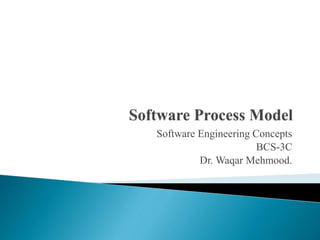Lec 9 Process Model.pptx
•Download as PPTX, PDF•
0 likes•2 views
Software process models in SE
Report
Share
Report
Share

Recommended
Recommended
More Related Content
Similar to Lec 9 Process Model.pptx
Similar to Lec 9 Process Model.pptx (20)
Software Development Life Cycle: Traditional and Agile- A Comparative Study

Software Development Life Cycle: Traditional and Agile- A Comparative Study
Recently uploaded
Recently uploaded (20)
8th International Conference on Soft Computing, Mathematics and Control (SMC ...

8th International Conference on Soft Computing, Mathematics and Control (SMC ...
NEWLETTER FRANCE HELICES/ SDS SURFACE DRIVES - MAY 2024

NEWLETTER FRANCE HELICES/ SDS SURFACE DRIVES - MAY 2024
Artificial intelligence presentation2-171219131633.pdf

Artificial intelligence presentation2-171219131633.pdf
Fuzzy logic method-based stress detector with blood pressure and body tempera...

Fuzzy logic method-based stress detector with blood pressure and body tempera...
Passive Air Cooling System and Solar Water Heater.ppt

Passive Air Cooling System and Solar Water Heater.ppt
Developing a smart system for infant incubators using the internet of things ...

Developing a smart system for infant incubators using the internet of things ...
UNIT-2 image enhancement.pdf Image Processing Unit 2 AKTU

UNIT-2 image enhancement.pdf Image Processing Unit 2 AKTU
Software Engineering Practical File Front Pages.pdf

Software Engineering Practical File Front Pages.pdf
Involute of a circle,Square, pentagon,HexagonInvolute_Engineering Drawing.pdf

Involute of a circle,Square, pentagon,HexagonInvolute_Engineering Drawing.pdf
Seizure stage detection of epileptic seizure using convolutional neural networks

Seizure stage detection of epileptic seizure using convolutional neural networks
Filters for Electromagnetic Compatibility Applications

Filters for Electromagnetic Compatibility Applications
Lec 9 Process Model.pptx
- 1. Software Engineering Concepts BCS-3C Dr. Waqar Mehmood.
- 2. In the early days of computing, the need for formal and well-planned life cycle methodologies was not well understood. Programmers tended to move directly from a very simple planning phase right into the construction step of the implementation phase. In other words, they moved directly from a very fuzzy, not well-thought-out system request into writing code.
- 3. Categorizing methodologies according to the sequencing of the SDLC phases and the amount of time and effort devoted to each. ◦ Structured Design ◦ Rapid Application Development (RAD) ◦ Agile Development
- 4. The first category is called structured design. Waterfall Development Parallel Development These methodologies became dominant in the 1980s, replacing the previous, ad hoc, and undisciplined approaches. Structured design methodologies adopt a formal step-by- step approach to the SDLC that moves logically from one phase to the next. Numerous process centered and data-centered methodologies follow the basic approach of the two structured design categories outlined next.
- 5. The parallel development methodology attempts to address the problem of long delays between the analysis phase and the delivery of the system. Instead of doing design and implementation in sequence, it performs a general design for the whole system and then divides the project into a series of distinct subprojects that can be designed and implemented in parallel. Once all subprojects are complete, there is a final integration of the separate pieces, and the system is delivered (see Figure 1-3).
- 6. Structured Design Rapid Application Development (RAD) 1. Incremental or Phased Development 2. Prototyping 3. Throwaway Prototyping Agile Development 1. Extreme Programming 2. SCRUM 3. Dynamic Systems Development Method (DSDM)
- 7. A second category of methodologies includes rapid application development (RAD)–based methodologies. RAD-based methodologies attempt to address both weaknesses of structured design methodologies by adjusting the SDLC phases to get some part of the system developed quickly and into the hands of the users. In this way, the users can better understand the system and suggest revisions that bring the system closer to what is needed.
- 8. Most RAD-based methodologies recommend that analysts use special techniques and computer tools to speed up the analysis, design, and implementation phases, such as ◦ CASE tools, ◦ fourth generation/visual programming languages that simplify and speed-up programming (e.g., Visual Basic), ◦ joint application design (JAD) sessions, and ◦ code generators that automatically produce programs from design specifications.
- 9. There are process-centered, data-centered and object- oriented methodologies that follow the basic approaches of the three RAD categories described below. 1. Incremental or Phased Development 2. Prototyping 3. Throwaway Prototyping
- 10. Structured Design Rapid Application Development (RAD) Agile Development ◦ Extreme Programming ◦ SCRUM ◦ Dynamic Systems Development Method (DSDM)
- 11. A third category of systems development methodologies is still emerging today: Agile development. These programming-centric methodologies have few rules and practices, all of which are fairly easy to follow. They focus on streamlining the SDLC by eliminating much of the modeling and documentation overhead, and the time spent on those tasks.
- 12. Three of the key principles that XP uses to create successful systems are ◦ simple coding performed by pairs of developers, ◦ Continuous testing, and ◦ close interactions with end users to build systems very quickly. After a superficial planning process, projects perform analysis, design, and implementation phases iteratively
